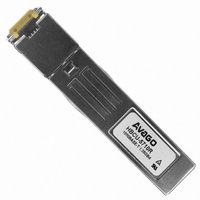HBCU-5710R Avago Technologies US Inc., HBCU-5710R Datasheet - Page 6

HBCU-5710R
Manufacturer Part Number
HBCU-5710R
Description
Fiber Optic Transceiver,Module
Manufacturer
Avago Technologies US Inc.
Datasheet
1.HBCU-5710R.pdf
(25 pages)
Specifications of HBCU-5710R
Data Rate
1.25Gbps
Wavelength
850nm
Voltage - Supply
3.3V
Connector Type
RJ45
Mounting Type
Through Hole
Lead Free Status / RoHS Status
Lead free / RoHS Compliant
Applications
-
Lead Free Status / RoHS Status
Lead free / RoHS Compliant, Contains lead / RoHS non-compliant
Other names
516-2009
Available stocks
Company
Part Number
Manufacturer
Quantity
Price
Table 2: 20-pin Connection Diagram Description
Notes:
1. TX Fault is not used and is always tied to ground.
2. TX Disable as described in the MSA is not applicable to the 1000BASE-T module, but is used for convenience as an input to reset the internal
3. Mod-Def 0,1,2. These are the module definition pins. They should be pulled up with a 4.7-10 KW resistor on the host board to a supply less than
4. LOS (Loss of Signal) is not used and is always tied to ground in Figure 4.
5. RD-/+: These are the differential receiver outputs. They are ac coupled 100 W differential lines which should be terminated with 100 W differential
6. V
7. TD-/+: These are the differential transmitter inputs. They are ac coupled differential lines with 100 W differential termination inside the module.
6
Pin
1
2
3
4
5
6
7
8
9
10
11
12
13
14
15
16
17
18
19
20
ASIC. This pin is pulled up within the module with a 4.7 KW resistor.
Low (0 – 0.4V):
Between (0.4V and 2.0 V):
High (2.0 – 3.465 V):
Open:
V
Mod-Def 0 is grounded by the module to indicate that the module is present
Mod-Def 1 is clock line of two wire serial interface for optional serial ID
Mod-Def 2 is data line of two wire serial interface for optional serial ID
at the user SerDes. The ac coupling is done inside the module and is thus not required on the host board. The voltage swing on these lines will
be between 370 and 2000 mV differential (185 – 1000 mV single ended) when properly terminated. These levels are compatible with CML and
LVPECL voltage swings.
current is 370 mA and the associated in-rush current will typically be no more than 30 mA above steady state after 500 nanoseconds.
The ac coupling is done inside the module and is thus not required on the host board. The inputs will accept differential swings of 500 – 2400
mV (250 – 1200 mV single ended), though it is recommended that values between 500 and 1200 mV differential (250 – 600 mV single ended)
be used for best EMI performance. These levels are compatible with CML and LVPECL voltage swings.
CC
CC
R and V
T + 0.3 V or V
Name
V
TX Fault
TX Disable
MOD-DEF2
MOD-DEF1
MOD-DEF0
Rate Select
LOS
V
V
V
RD-
RD+
V
V
V
V
TD+
TD-
V
CC
CC
EE
EE
EE
EE
EE
EE
EE
CC
T
R
R
R
R
T
T
R
T
T are the receiver and transmitter power supplies. They are defined as 3.3 V ± 5% at the SFP connector pin. The maximum supply
CC
R + 0.3 V.
Transceiver on
Undefined
Transceiver in reset state
Transceiver in reset state
Function/Description
Transmitter Ground
Transmitter Fault Indication - High Indicates a Fault
Transmitter Disable - Module disables on high or open
Module Definition 2 - Two wire serial ID interface
Module Definition 1 - Two wire serial ID interface
Module Definition 0 - Grounded in module
Not Connected
Loss of Signal - High Indicates Loss of Signal
Receiver Ground
Receiver Ground
Receiver Ground
Inverse Received Data Out
Received Data Out
Receiver Ground
Receiver Power - 3.3 V +/- 5%
Transmitter Power - 3.3 V +/- 5%
Transmitter Ground
Transmitter Data In
Inverse Transmitter Data In
Transmitter Ground
MSA Notes
Note 1
Note 2
Note 3
Note 3
Note 3
Note 4
Note 5
Note 5
Note 6
Note 6
Note 7
Note 7





















